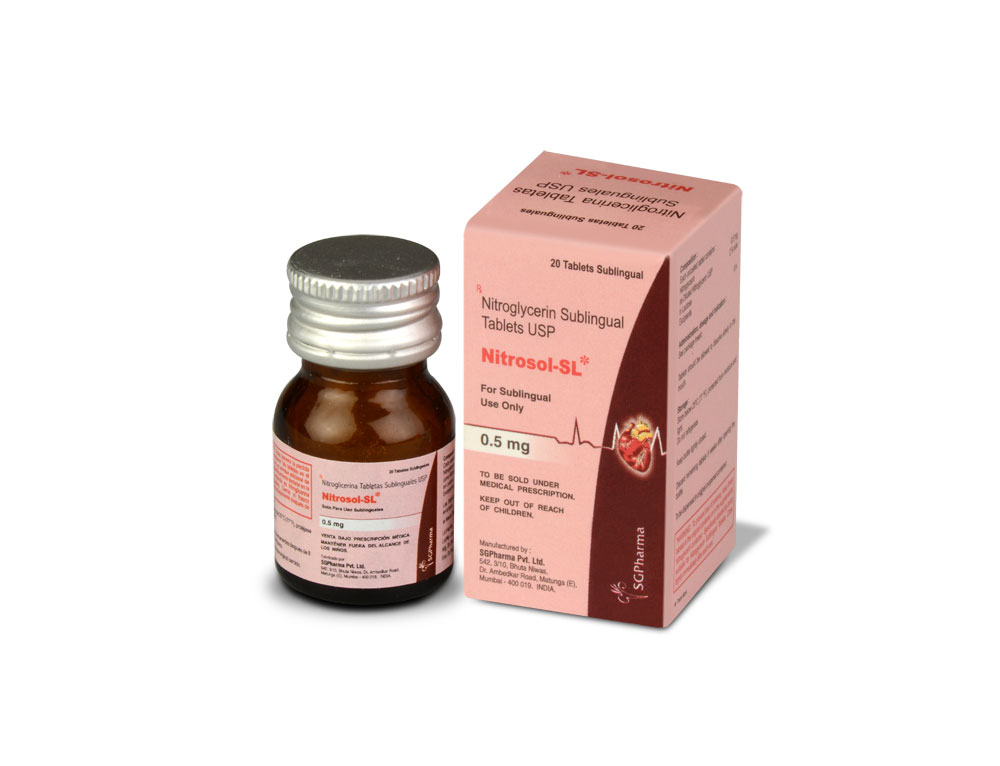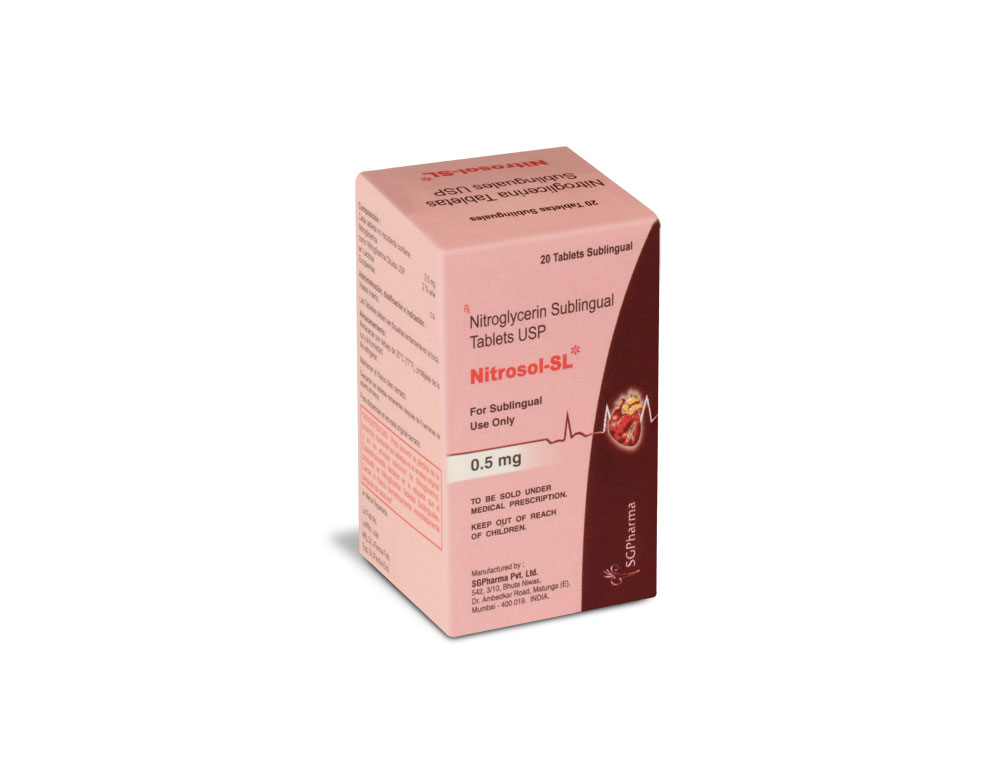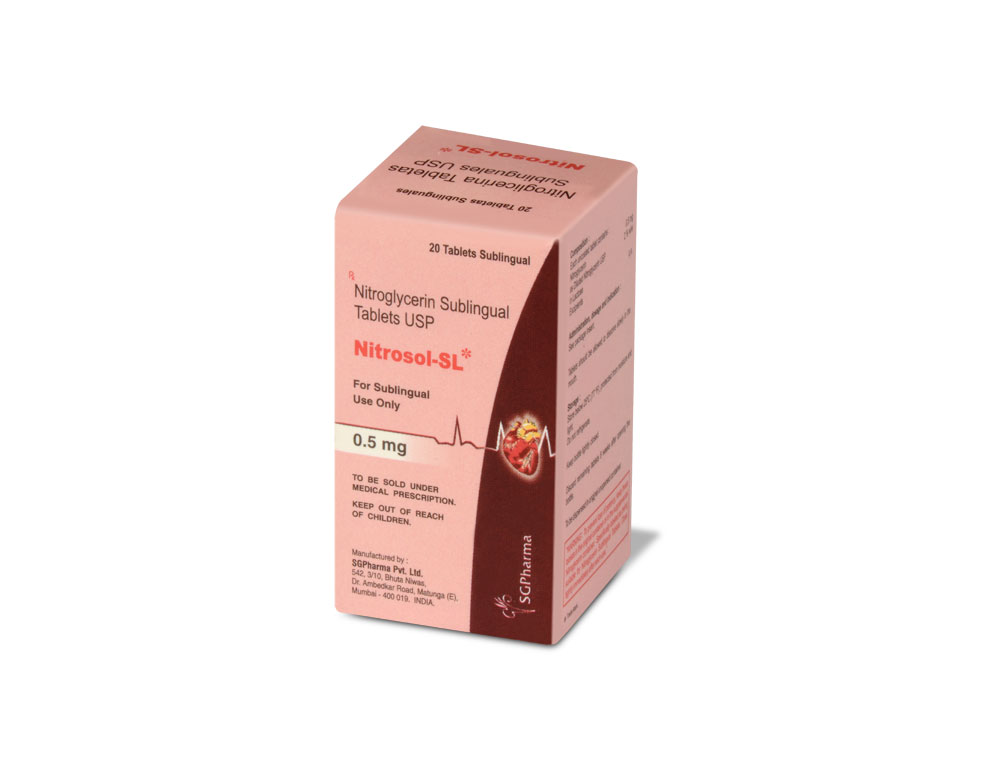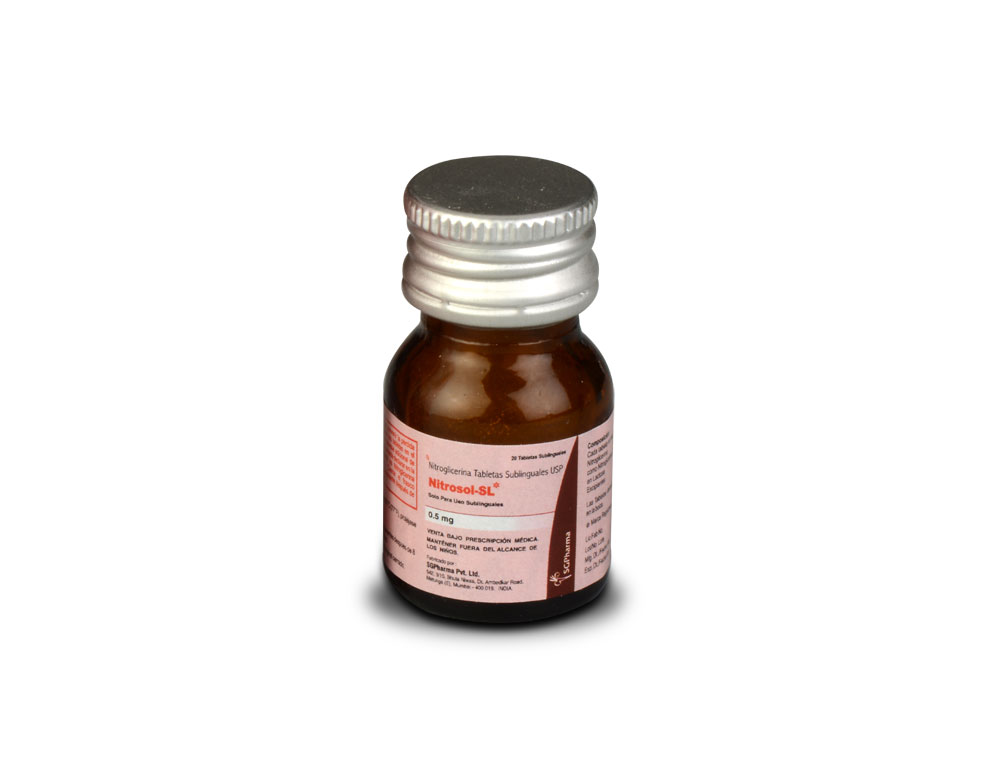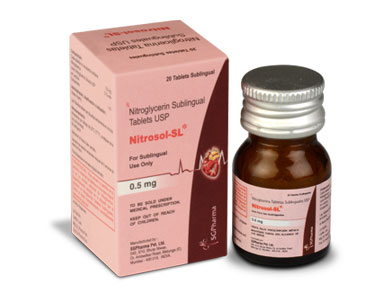
0.5 mg
For the use of a Registered Medical Practitioner or a Hospital or a Institution only.
NITROSOL–SL (Nitroglycerin) is an organic nitrate vasodilator, active on both arteries and veins. Chemically Nitroglycerin is 1,2,3 – propanetriol trinitrate. The molecular formula is C3H5N3O9 and the molecular weight is 227.09.
STRUCTURAL FORMULA :
Its structural formula is :
-Structure.jpg)
NITROSOL–SL is a white coloured , circular, biconvex tablets having both sides plain.
COMPOSITION :
Each uncoated tablet contains :
Nitroglycerin ……………………………… 0.5 mg
as Diluted Nitroglycerin USP ………… 2 % w/w
in Lactose
Excipients………………………………….. q.s.
ACTIONS :
Nitroglycerin, an organic nitrate, is a vasodilator. Its principal pharmacological action is the relaxation of vascular smooth muscle. Nitroglycerin produces, in a dose-related manner, dilation of both arterial and venous beds. Dilation of the post-capillary vessels, including large veins, promotes peripheral pooling of blood and decreases venous return to the heart reducing left ventricular end diastolic pressure (pre-load). Arteriolar relaxation reduces systemic vascular resistance and arterial pressure (after-load). Myocardial oxygen consumption or demand (as measured by the pressure rate product, tension time index and stroke work index) is decreased by both the arterial and venous effect of Nitroglycerin and a more favourable supply demand ratio can be achieved. Therapeutic doses of Nitroglycerin reduce systolic, diastolic and mean arterial blood pressure. Effective coronary perfusion pressure is usually maintained, but can be compromised if blood pressure falls excessively or increased heart rate decreases diastolic filling time.
Nitroglycerin reduces elevated central venous and pulmonary capillary wedge pressures, pulmonary vascular resistance and systemic vascular resistance. Heart rate is usually slightly increased, presumably a reflex response to the fall in blood pressure, Cardiac index may be increased, decreased or unchanged. Patients with elevated left ventricular fillings pressure and systemic vascular resistance values in conjunction with a depressed cardiac index are likely to experience an improvement in cardiac index. Alternatively, when filling pressures and cardiac index are normal, cardiac index may be slightly reduced following nitroglycerin administration.
PHARMACOKINETICS :
Nitroglycerin is rapidly absorbed following sublingual administration. Its onset of action is approximately one to three minutes. Significant pharmacologic effects are present for 30 to 60 minutes following administration by the above route. Nitroglycerin is rapidly metabolized to dinitrates and mononitrates, with a short half-life, estimated at 1 to 4 minutes. A liver reductase enzyme is of primary importance in the metabolism of nitroglycerin to glycerol nitrate metabolites and organic nitrate. Two active major metabolites 1,2- and 1,3-dinitroglycerols are less potent vasodilators and have longer half-lives than the parent compound. Dinitrates are metabolized to mononitrates and ultimately glycerol. The monohydrate is not considered biologically active with respect to cardiovascular effects. At plasma concentrations of between 50 and 500 ng/ml, the binding of nitroglycerin to plasma proteins is approximately 60 %, while that of 1,2dinitroglycerin and 1,3-dinitroglycerin is 60 % and 30 %, respectively. The activity and half-life of 1,2-dinitroglycerin and 1,3-dinitroglycerin are not well characterized. The mononitrate is not active.
INDICATION :
NITROSOL–SL is indicated for the acute relief of an attack or prophylaxis of angina pectoris due to coronary artery disease.
Administration :
NITROSOL–SL Tablet is for sublingual use only. Tablets should be allowed to dissolved slowly in the mouth.
Dosage :
One tablet should be dissolved under the tongue or in the buccal pouch at the first sign of an acute anginal attack. The dose may be repeated approximately every five minutes, until relief is obtained. If the pain persists after a total of 3 tablets in a 15-minute period, prompt medical attention is recommended. NITROSOL–SL may be used prophylactically 5 to 10 minutes prior to engaging in activities which might precipitate an acute attack. During administration the patient should rest, preferably in the sitting position. No dosage adjustment is required in patients with renal failure.
Use in Pregnancy : Pregnancy category C
Animal reproduction studies have not been conducted with nitroglycerin. It is also not known whether nitroglycerin can cause foetal harm when administered to a pregnant woman or can affect reproduction capacity. Nitroglycerin should be given to a pregnant woman only if clearly needed.
Nursing Mother :
It is not known whether nitroglycerin is excreted in human milk. Because many drugs are excreted in human milk, caution should be exercised when intravenous nitroglycerin is administered to a nursing woman.
Paediatric Use :
The use of NITROSOL – SL in children is not recommended, as its safety and effectiveness in children have not been established.
INTERACTIONS AND INCOMPATIBILITY :
Concomitant use of nitrates and alcohol may cause hypotension. Patients receiving antihypertensive drugs, beta-adrenergic blockers or phenothiazines and nitrates should be observed for possible additive hypotensive effects. Marked orthostatic hypotension has been reported when calcium channel blockers and organic nitrates were used concomitantly. Dose adjustment of either class of agent may be necessary. Aspirin may decrease the clearance and enhance the haemodynamic effects of sublingual nitroglycerin. A decrease in the therapeutic effect of sublingual nitroglycerin may result from use of long-acting nitrates.
Drug/laboratory test interactions
Nitrates may interfere with the Ziatkis-Zak colour reaction causing a false report of decreased serum cholesterol.
SIDE EFFECTS :
The most frequent possible side effect (natural, expected and unavoidable drug actions) in patients treated with NITROSOL–SL is headache which occurs in approximately 2 % of patients. Other side effects (unusual, unexpected and infrequent reactions) occurring in less than 1 % patients are the following : tachycardia, nausea, vomiting, apprehension, restlessness, muscle twitching, retrosternal discomfort, palpitations, dizziness and abdominal pain.
INFORMATION FOR PATIENTS :
If possible, patients should sit down when taking
NITROSOL–SL. This eliminates the possibility of falling due to lightheadedness or dizziness.
NITROSOL–SL may produce a burning or tingling sensation when administered sublingually; however, the ability to produce a burning or tingling sensation should not be considered a reliable method for determining the potency of the tablets.
NITROSOL–SL should be kept in the original glass container, tightly capped. The cotton should be discarded once the bottle is opened.
OVERDOSAGES AND TREATMENT OF OVERDOSAGES :
Accidental overdosage of NITROSOL–SL may result in severe hypotension and reflex tachycardia which can be treated by elevating the legs and decreasing or temporarily terminating the infusion until patient’s condition stabilises. Since the duration of haemodynamic effects following administration is quite short, additional corrective measures are usually not required. However, if further therapy is indicated, administration of an intravenous alphaadrenergic agonist (e.g. Methoxamine or Phenylephrine) should be considered. Infusions of plasma or suitable electrolyte solutions should also be considered.
STORAGE :
Store below 30°C ( 86°F), protected from moisture and light.
Do not refrigerate.
Keep bottle tightly closed. Discard remaining tablets 8 weeks after opening the bottle. To be dispensed in original unopened container
WARNING :
To prevent loss of potency, keep these tablets in the original container or in a supplemental Nitroglycerin container specifically labeled as being suitable for Nitroglycerin Sublingual Tablets. Close tightly immediately after each use.

 Cardiovascular
Cardiovascular



